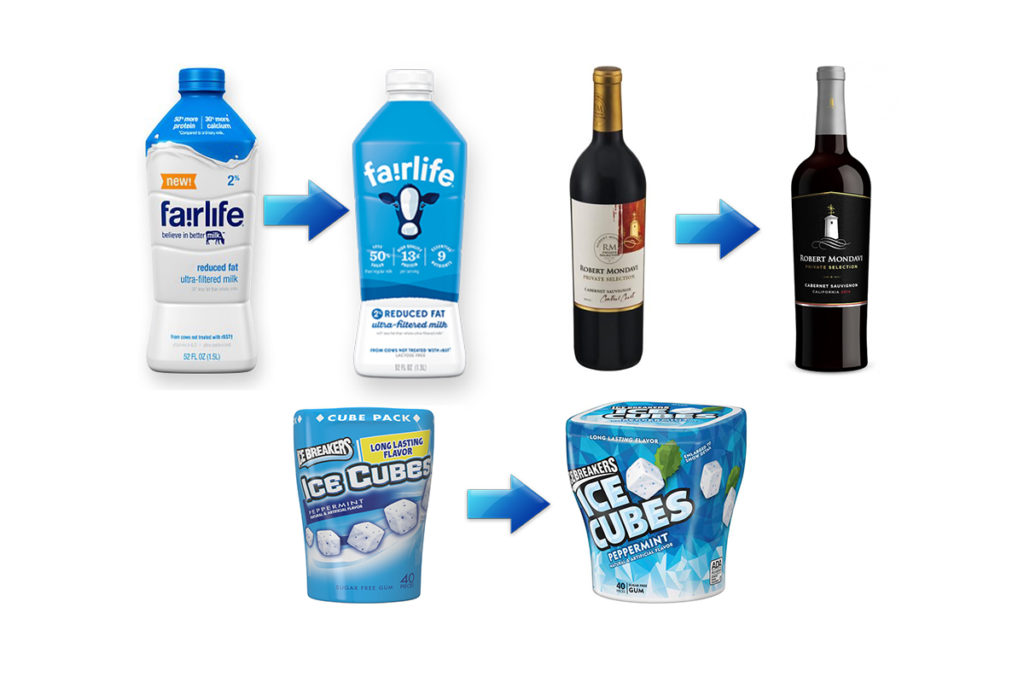Nielsen, in partnership with package design website The Dieline, has announced three winners for their 2018 Nielson Design Impact Awards. The three winners include Coca-Cola’s Fairlife milk, Hershey’s Ice Breakers Ice Cubes gum and Constellation Brands’ Robert Mondavi Private Selection wine. This award acknowledges successful package redesigns in the food industry that were brought to market over the past 2 years and it highlights the importance of package design when it comes to attracting consumers.
“In order for companies to compete in today’s dynamic consumer landscape, good package design has become table stakes,” said Laura Richardson, vice president of design solutions at Nielsen. “Part of the impetus for establishing the Nielsen Design Impact Awards was to create methodologies by which to judge the effectiveness of design. The right redesign can have major benefits for products—including significant sales lifts and greater consumer engagement.”
According to a release, hundreds of fast moving consumer goods (FMCG) brands and associated design agencies submitted their top package redesigns, that were launched between January 1, 2015, and March 1, 2017, for this award. The second annual Design Impact Awards evaluated these submissions by their appearance and in-market performance by using Nielson’s Retail Measurements Sales data. The market research organization compared the in-market performance of each package redesign submission with their performance prior to their package redesign. The winners of this award demonstrated a significant increase in dollar sales after launching their package redesigns. In addition, Nielson surveyed thousands of consumers on what package designs spoke to them the most in regards to their food preferences and if they were more likely to choose the new package designs over the old ones.
The results narrowed it down to five submissions, three of which were selected for the award with the other two receiving honorable mentions. Fairlife, Ice Breakers Ice Cubes and Robert Mondavi Private Selection stood out for their unique and eye-catching package redesigns, while Sabra Guacamole and Tessemae’s Organic Salad Dressing received honorable mentions.
Fairlife’s new packaging included new brightly colored bottles with large serving content logos that highlight appealing qualities such as the fact that it contains 13 grams of protein, 50 percent less sugar than regular milk and nine essential nutrients per serving. Ice Breakers introduced a new cup shaped container that utilizes bright colors with a cracked ice design along with large text and an enlarged image of the gum product. Robert Mondavi Private Selection launched a new black and gold label with white and gold text. Sabra Guacamole reduced their cardboard casing for their product and simplified their imagery while adding a green background to the wrapper, which made the product appear more natural with an avocado-like color. Tessemae’s also simplified their package design to have a cleaner look.
All five companies utilized a maximum of 2 colors for the background of their packaging because consumers have been noted to appreciate simple and clean packaging designs that seem more transparent and less sensationalized to them. In addition, all companies other than Robert Mondavi used imagery or colors to depict the flavor or ingredients in their product. For example, Ice Breakers used a green mint leaf for their mint flavored gum and Fairlife had a chocolate colored bottle for their chocolate milk product. Another notable quality: all five brands had products that were packaged in resealable containers.
Such product qualities are currently valuable to consumers who are oversaturated with food products to choose from. By highlighting appealing qualities on packaging and utilizing bright attractive colors while also incorporating resealability for freshness, food companies will be able to stand out on the shelves.
“In a growth challenged marketplace, it’s important for marketers to truly understand the value a successful package redesign can bring to a business’ bottom line. In this year’s analysis we had the privilege to review a number of impressive submissions. We saw across the board that brands are thinking about how the design of their product packaging would work not only in-stores but also for shop-ability and share-ability via social media. Ultimately, this year’s winners were best in class at creatively using their pack redesign as the vehicle to effectively grab consumer attention at shelf and drive purchase behavior,” said Richardson.












Join or login to leave a comment
JOIN LOGIN